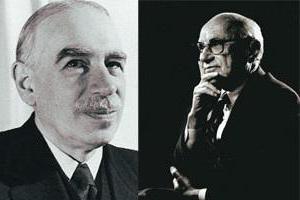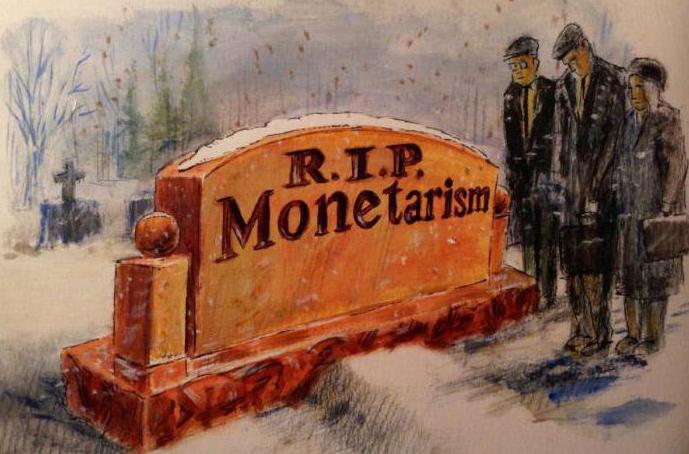Monetarism is a school of economic thought that defends the role of state control over the amount of money in circulation. Representatives of this direction believe that it affects the volume of production in the short term and the level of prices in a longer period. Monetarism policy focuses on targeting money supply growth rates. Long-term planning is valued here, not decision making depending on the situation. The key representative of the direction is Milton Friedman. In his main work, The Monetary History of the United States, he argued that inflation was primarily associated with unreasonable money supply in circulation and advocated its regulation by the country's central bank.

Key Features
Monetarism is a theory that focuses on the macroeconomic effects of money supply and the activities of central banks. It was formulated by Milton Friedman. In his opinion, an excessive increase in the money supply in circulation irreversibly leads to inflation. The task of the central bank is solely to maintain price stability. The school of monetarism originates from two historically antagonistic movements: the tight monetary policy that was prevalent at the end of the 19th century, and the theories of John Maynard Keynes, which became widespread in the interwar period after an unsuccessful attempt to restore the gold standard. Friedman, on the other hand, focused his research on price stability, which depends on the balance between supply and demand of money. He summarized his findings in a joint work with Anna Schwartz, “The Monetary History of the United States in 1867-1960.”
Theory Description
Monetarism is a theory that sees inflation as a direct result of an excessive supply of money. This means that the responsibility for it lies entirely with the central bank. Friedman originally proposed a fixed monetary rule. According to him, the money supply should increase automatically by k% annually. Thus, the central bank will lose its freedom of action, and the economy will become more predictable. Monetarism, whose representatives believed that rash manipulation of money supply cannot stabilize the economy, is primarily a long-term planning that prevents emergencies, rather than attempts to quickly respond to them.

Denial of the need for a gold standard
Monetarism is a trend that has gained distribution after World War II. Most of its representatives, including Friedman, see the gold standard as an impractical vestige of the old system. Its undoubted advantage is the existence of internal restrictions on the growth of money. However, population growth or increased trade irreversibly in this case leads to deflation and a drop in liquidity, since in this case it all depends on the extraction of gold and silver.
Becoming
Clark Warburton is credited with the first monetary interpretation of business fluctuations. He described it in a series of articles in 1945. So the modern directions of monetarism arose. However, the theory became widespread after Milton Friedman introduced the quantitative theory of money in 1965. It existed long before him, but Keynesianism, which dominated at that time, called it into question.Friedman believed that the expansion of the money supply would lead not only to an increase in savings (with a balance of supply and demand, people have already made the necessary savings), but also to an increase in total consumption. And this is a positive fact for national production. The growing interest in monetarism is also due to the Keynesian economy’s inability to overcome unemployment and inflation after the collapse of the Bretton Woods system in 1972 and the oil crises of 1973. These two negative phenomena are directly interconnected, the solution of one of the problems leads to an exacerbation of the other.

In 1979, US President Jimmy Carter appointed Paul Walker as head of the Federal Reserve. He limited the supply of money in accordance with the Friedman rule. The result was price stability. Meanwhile, Margaret Thatcher, a spokeswoman for the conservative party, won the election in Britain. Inflation at that time rarely dropped below 10%. Thatcher decided to use monetary measures. As a result, by 1983 the inflation rate decreased to 4.6%.
Monetarism: representatives
Among the apologists in this area are such outstanding scientists:
- Karl Brunner
- Phillip D. Kagan.
- Milton Friedman
- Alan Greenspan.
- David Leidler.
- Allan Meltzer.
- Anna Schwartz.
- Margaret Thatcher.
- Paul Walker.
- Clark Warburton.

Nobel laureate M. Friedman
We can say that the theory of monetarism, no matter how strange it may sound, began with Keynesianism. Milton Friedman at the beginning of his academic career was a supporter of fiscal regulation of the economy. However, he later came to the conclusion that the interference with the national economy was erroneous by changing government spending. In his famous works, he argued that "inflation is always and everywhere a monetary phenomenon." He opposed the existence of the Federal Reserve, but believed that the task of the central bank of any state was to maintain the supply and demand of money in equilibrium.
United States Monetary History
This famous work, which was the first large-scale study using the methodological principles of a new direction, was written by Nobel laureate Milton Friedman in collaboration with Anna Schwartz. In it, scientists analyzed the statistics and came to the conclusion that the money supply had a significant impact on the US economy, especially on the passage of business cycles. This is one of the most outstanding books of the last century. The idea of writing it was proposed by the Chairman of the Federal Reserve Arthur Burns. The United States Monetary History was first published in 1963.
The origins of the great depression
Work on the book The Monetary History of the United States has been conducted by Friedman and Schwartz under the auspices of the National Bureau of Economic Research since 1940. She was published in 1963. The chapter on the Great Depression appeared two years later. In it, the authors criticize the Federal Reserve for inaction. In their opinion, he was supposed to maintain a stable supply of money and give loans to commercial banks, and not bring them to mass bankruptcy. Monetary History uses three key indicators:
- The cash ratio on the accounts of individuals (if people believe in the system, then they leave more on the cards).
- The ratio of deposits to bank reserves (in stable conditions, financial and credit institutions occupy more).
- Money of “increased efficiency” (that which serves as cash or highly liquid reserves).

Based on these three indicators, you can calculate the money supply. The book also discusses the problems of using the gold and silver standard. The authors measure the velocity of money and try to find the best way to intervene in the economy for central banks.
Contribution to Science
Thus, monetarism in the economy is a direction that for the first time presented a logical justification for the great depression. Previously, economists saw its origins in the loss of consumer and investor confidence in the system. Monetarists responded to the challenges of modern times by proposing a new way to stabilize the national economy when Keynesianism was no longer working. Today, in many countries, a modified approach is used, which involves greater government intervention in the economy to regulate the speed of circulation of money and their quantity in circulation.

Criticism of the conclusions of Friedman
According to Alan Blinder and Robert Solow, fiscal policy becomes ineffective only when demand elasticity money is zero. However, in practice this situation does not occur. The reason for the Great Depression Friedman considered the inaction of the Federal Reserve Bank of the USA. However, some economists, such as Peter Temin, disagree with this conclusion. He believes that the origins of the great Depression are exogenous, not endogenous. In one of his works, Paul Krugman argues that the 2008 financial crisis showed that the state is not in a position to control “broad” money. In his opinion, their proposal is almost not related to GDP. James Tobin notes the importance of the findings of Friedman and Schwartz, however, he calls into question their proposed indicators of the velocity of money and their impact on business cycles. Barry Eichengreen proves the impossibility of vigorous activity of the Federal Reserve during the Great Depression. In his opinion, he prevented the increase in money supply gold standard. He questions the other conclusions of Friedman and Schwartz.

On practice
Monetarism in the economy emerged as a direction that was supposed to help deal with problems after the collapse of the Bretton Woods system. A realistic theory should explain the deflationary waves of the late 19th century, the great depression, stagflation after the Jamaican conference. According to monetarists, the velocity of money directly affects the fluctuations in business activity. Thus, the cause of the Great Depression is the lack of money supply, which led to a drop in liquidity. Any major fluctuations and price volatility are due to improper central bank policies. The increase in money supply in circulation is usually associated with the need to finance government spending so you need to reduce them. Macroeconomic theory until the 1970s, on the contrary, insisted on their expansion. The recommendations of the monetarists have proven effective in practice in the United States and Great Britain.
Modern monetarism
Today, the Federal Reserve System uses a modified approach. It implies wider state intervention in the event of temporary instability in market dynamics. Including it should regulate the speed of money circulation. European colleagues prefer more traditional monetarism. However, some researchers believe that it was this policy that caused the weakening of currencies in the late 1990s. From this time on, the conclusions of monetarism begin to be called into question. The debate about the role of this school of economic thought in trade liberalization, international investment and the effective policies of central banks has not subsided to this day.
However, monetarism remains an important theory on the basis of which new ones are built. His findings are still relevant and deserve a detailed study. The works of Friedman are widely known in the scientific community.








